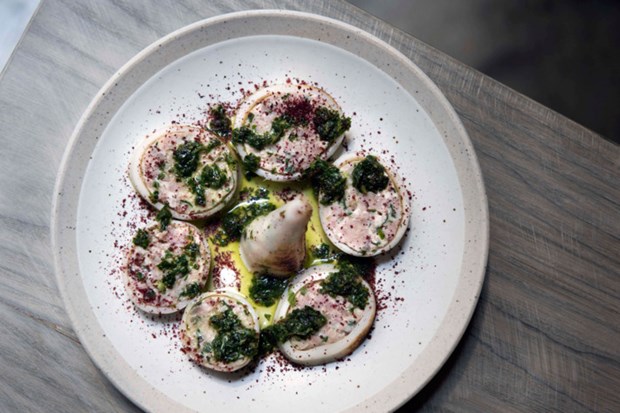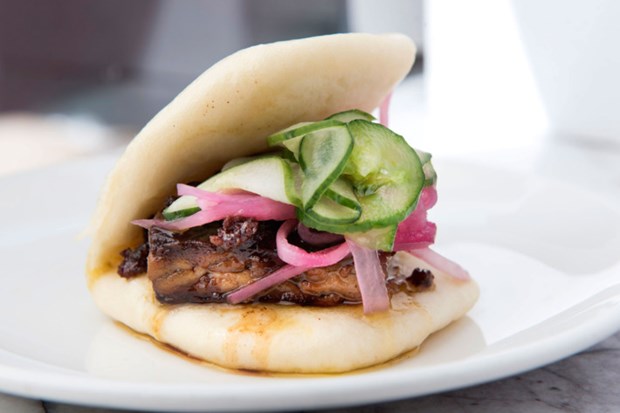John
Nguyen — who opened Hanoi House in January — was more interested in California.
Nguyen grew up in Orange County; he explained at the time of the restaurant’s
opening, “Some people from Orange County came in and said, ‘It tastes just like
O.C.’” He added, “I just smiled, that’s all I want.”

At Atoboy, Korean-style stuffed squid is served with Italian salsa verde. Photo: Liz Clayman
The
menu features dishes like frogs’ legs in Cajun rice batter, and morning glory
cooked in brown-butter fish sauce. Nguyen’s approach is typical of many young
chefs in New York: Even as their restaurants might be rooted in specific
countries, the cooking emphasizes a melting-pot mentality, and harmonious
marriages of culturally disparate ingredients.
Technically,
it is “fusion” cooking. But it’s not the kind of fusion that was pioneered by
chefs like Wolfgang Puck, or Norman Van Aken, who melded Caribbean and European
cuisines in Florida, in the ’80s and ’90s. That cooking, by and large, was
defined by chefs incorporating ingredients from mostly East Asian cuisines into
cooking that was otherwise rooted in the European tradition. Take, for example,
China Grill’s “Oriental antipasto,” which in 1993 featured pickled cauliflower
and beets, alongside scallion-studded mozzarella. There was also Ruby Foo’s
PB&J rolls and Jean-Georges Vongerichten’s Vong, which served roasted
lobster tossed with red, green, and yellow curry paste mixed with white port.
(“Passionate purists will grumble,” Gael Greene wrote at the time.)
Fusion
was brash, and the mash-ups were meant to impress with an element of surprise
and the chefs’ ability to pull together ingredients from all over the world. In
her review of China Grill, Ruth Reichl called it “air-freight cuisine with a
global reach; surely it is no accident that Australian organic free-range lamb
is listed on the menu, along with maki rolls, Peking duck salad, escabeche,
fettuccine and C’Asian gumbo.”
What’s
different now is that the aim isn’t to create previously unseen culinary
combos; the chefs — many first-generation Americans born in immigrant families
— are trying to re-create their own upbringings. Chris Cheung is the rare chef
who has seen both sides of the fusion coin. He was part of the opening team at
Jean-Georges, and cooked at China Grill. In 2015, he opened East Wind Snack
Shop, where he mixes his family’s Cantonese cooking, a touch of Shanghainese
technique, and distinctly Western ingredients.
“When
you’re trying to mix up different ingredients, it tends to be a lot better when
it’s coming from your childhood — it’s coming from instinct,” Cheung argues.
“It’s just different than a chef who was inspired by just one trip he took for
two weeks in China, and saw some things on the street he liked. That
inspiration, while it’s good, is not the same as when you’ve been inspired by
it your whole life.”

At Fung Tu, steamed buns are served with foie gras and “lap cheong marmelade.” Photo: Liz Clayman
It’s
no surprise, then, that this is a subtler approach, one that often infuses a
gentle Western influence into various East Asian cuisines. The style is
exemplified by the saffron aïoli served with the sake-steamed clams at Bessou,
the foie gras bao with Chinese-sausage marmalade at Fung Tu, and corned-beef
ramen at Mu Ramen. At Atoboy, the kitchen finishes Korean-style stuffed squid
with distinctly Western salsa verde. In Santa Monica, there’s crisp ham in the
spicy wontons at Cassia. Outside the realm of fine dining, during the 2000s,
Vietnamese cooks in Houston started infusing crawfish boils with Vietnamese
flavors — creating a new southern classic that spread to cities around the
country. Out in San Francisco, Mister Jiu’s offers salt-and-vinegar shrimp
chips, pork buns with Dutch crunch (a bread popular in the Bay Area), and Peking
duck served with peanut-butter hoisin. As owner, Brandon Jew, a Bay Area native
who has cooked in the region for 15 years, puts it, “It would be inauthentic
for me to cook food that I would be cooking for Chinese people in China.” (One
could argue — quite easily — that David Chang helped lay the groundwork in New
York by embracing ramen, Korean gamjatang, and southern country ham in equal
measure at the early Momofuku restaurants.)
In
many ways, chefs have freedom to play with these cuisines because diners are so
much more familiar with the flavors. There’s also an issue of historical
timing: “Clearly, with the whole world of Chinese food, immigration quotas and
regulations had an enormous effect on our industry,” notes Chinese food
authority Ed Schoenfeld, of RedFarm and Decoy. In 1965, the Hart-Celler Act put
an end to race-based quotas and a history of immigration policies that
severely, or totally, restricted Asian immigration, and barred
Chinese-Americans from owning property or businesses. An immigration boom
subsequently occurred, with the Chinese-American population, for example,
growing roughly 1,400 percent from 1960 to 2010. This invigorated Chinese,
Japanese, Korean, and other East Asian cultures and cuisine in the United
States, and it’s reshaping American culture and cuisine.
In
other words, this is food that best represents America right now. More than
being a fusion of different cuisines, it’s a whole approach to modern American
cooking. The chefs work with ingredients and techniques they know, and those
things happen to be from cuisines originating on opposite sides of the planet.
Nguyen’s style at Hanoi House, for example, is a reflection of the Vietnamese
community’s deepening roots in California. Within the Chinese restaurant
community, there’s a similar story, as mostly first- and second-generation
chefs, Wu says, are “starting to do their thing.”
“There’s
this preconceived notion that ‘Asian’ food needs to be a certain way, and I
just feel like we should be past that point,” Bessou owner Maiko Kyogoku says.
“To be completely honest, I think we should’ve opened up a New American
restaurant because that’s how I see the food sometimes.”
By Chris
Crowley/ Grub Street